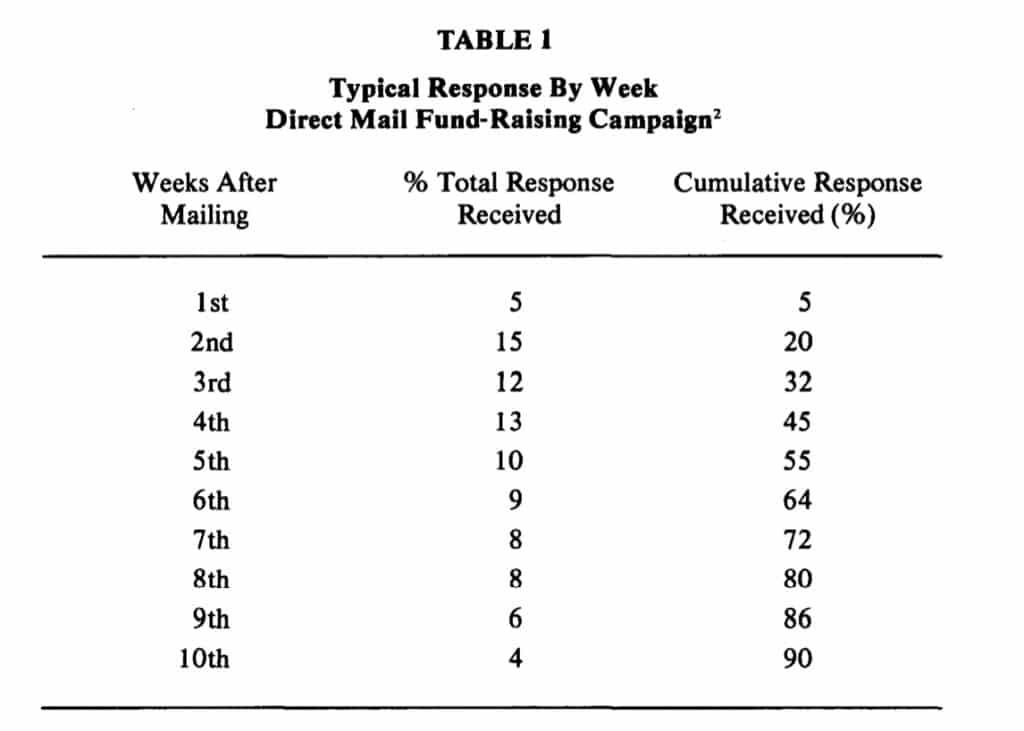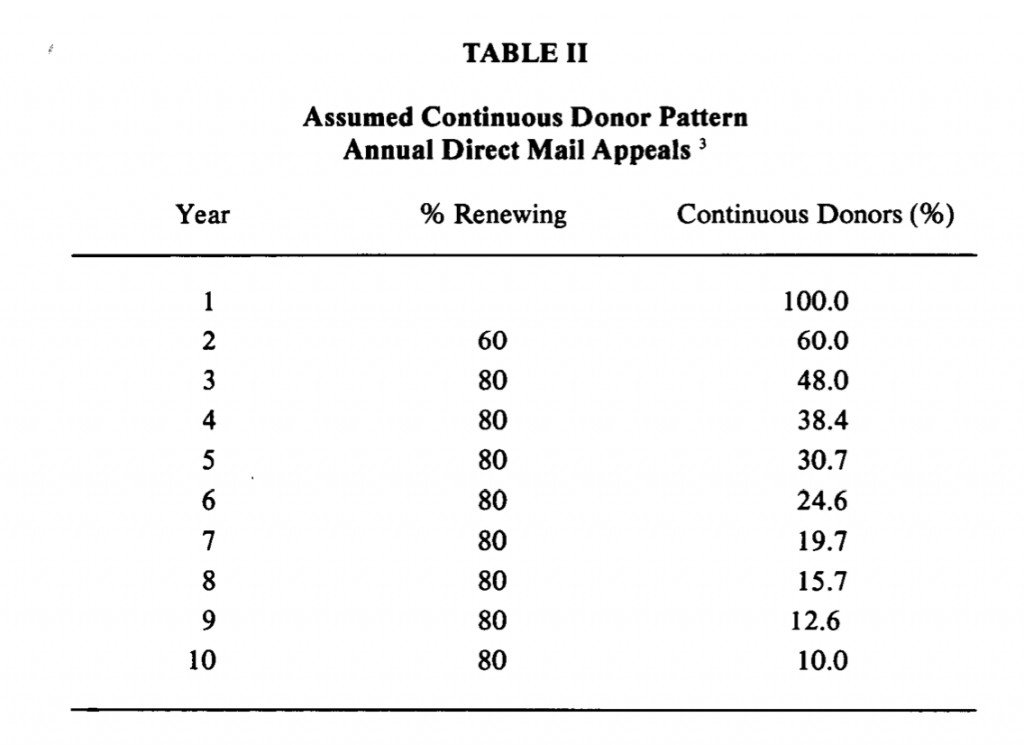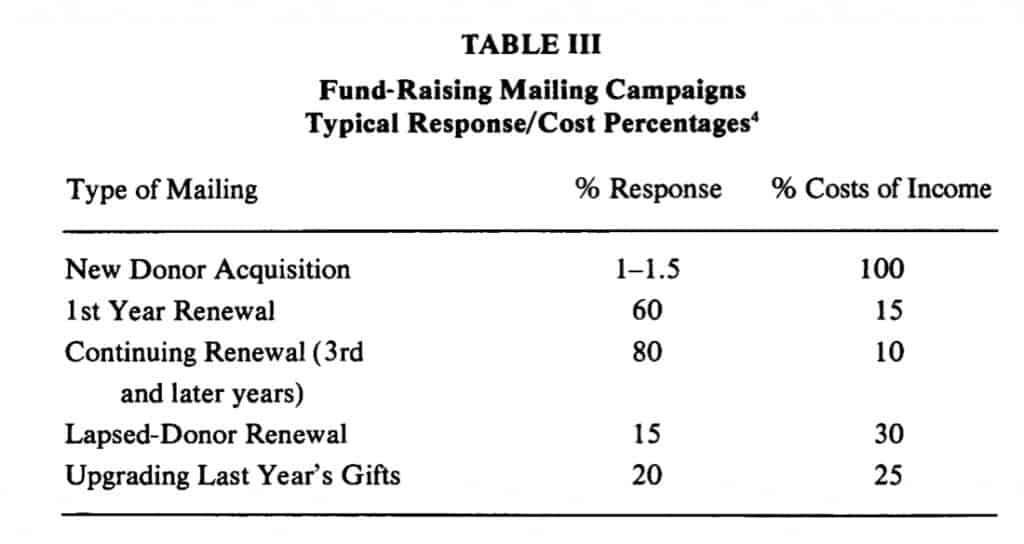Does your organization keep its donor records in a way that helps it to be a more successful fund raiser? If you are like most charitable organizations, every year you are trying to:
– get more and higher average gifts from your current supporters;
– find new donors to replace those you are continually losing;
– reduce your steadily increasing campaign and administrative costs;
– raise more money.
Your ability to achieve these difficult objectives can be dramatically affected by the way you store and manage your donor information. The following review will help you to assess the ability of your current information management system to maximize the results of your fund-raising activities, and will offer suggestions for improving your system if you perceive deficiencies.
Annual Fund-Raising Compaigns
Over the years, organizations conducting consistently successful annual appeals have shown that, in general, their success is based on a high degree of donor loyalty. They have also found that there are six factors which have a direct bearing on that loyalty:
1. Gift Size: usually the higher the average gift, the higher the loyalty of the donor.
2. Number of Years As Donor. the longer a person donates to your organization, the more likely he or she is to respond to a donation request.
3. Personal Involvement: the more involved a person is in the activities of your organization, the more likely he or she is to respond to a donation request.
4. Use of Facilities/Services: the more closely acquainted the individual is with your organization through personal use or experience of it, the more likely he or she is to contribute.
5. Communications: the more a person knows about your organization through newsletters, magazines, annual reports etc., the more likely he or she is to contribute.
6. Appreciation: the more appreciation an organization shows for donors through acknowledgements and references to the importance of their gifts, the more likely they are to give again.
Question:
Are you now able to acquire, store, manage and put to work the donor information necessary to maximize the loyalty and long-term giving potential of your present donors? … your future donors?
Donor Acquisition: Getting the First Gift1
Donor acquisition is often mistakenly called fund raising. In fact, donor-acquisition programs rarely show a net profit This is particularly true if donors are sought through direct response (direct mail, telemarketing, etc.) appeals. Here, success is measured by breaking even or, more usually, just keeping losses to a reasonable level.
In fact, the future income potential from a large base of newly acquired donors is so substantial, that a non-profit can spend up to $1.56 to take in the first dollar
… and still make a profit on the first renewal. Donor acquisition “investment losses” which are made up by starting the donor renewal cycle at the end of six to eight months will produce the best of all possible outcomes—a donor acquisition program that shows a profit within the first 12-month accounting period.
Question:
How do you ensure that your current donors get renewal and not acquisition letters? Your donor information system should be able to guarantee this for you. Does it?
Donor Renewal: Getting The Second Gift
The function of a Donor Renewal Program/Cycle is to set up a long-term donor giving pattern which yields maximum income at the lowest possible cost per dollar raised.
Donor Renewal Rates
Most fund-raising organizations have found that, depending upon the method of acquisition, renewal rates for annual giving programs range from 40 per cent to 60 per cent in the first year and 80 per cent thereafter, assuming adequate follow-up mailings are made.
Successful, Cost-Effective Renewal Campaigns
These campaigns may well involve a series of appeals combining written, and/or telephoned personal renewal requests. Their success will hinge on your organization’s ability to:
– segment its donor base by date of the initial gift;
– produce personalized solicitation materials referring to these gift amounts; and
– accurately track, record and analyze in detail, the response.
When conducting your mailed renewal or acquisition programs you may use the services of a list broker and/or lettershop:
List Broker: a specialist who makes all the necessary arrangements for an organization to make use of the list( s) of another organization or company. A broker’s services may include research, list selection, recommendations and evaluation. Lettershop: a company which specializes in compiling and distributing mailing packages. Its services may include list brokerage, the compiling of computerized mailing lists, the addressing and assembling of mailing packages, bagging, sorting, and delivering to Canada Post sorting plants.
To enable you to work with a lettershop and conduct effective renewal mailing campaigns, your donor record system should permit you to produce lists of donor names on computer tape. These computerized donor lists will usually be used to conduct
Duplicate Elimination Programs: a procedure which ensures that no matter how many times a donor’s or prospect’s name appears on a mailing list and no matter how many lists contain that name and address, it will be accepted for mailing only once; and
Merge/Purge Programs: The combining of two or more lists and elimination of duplicates at the same time.
Question:
Does your current donor record system allow you to conduct successful, cost effective renewal programs using a lettershop and its sophisticated computer techniques?
Donor Reactivation: Getting the Lapsed Donor to Give Again
Donor renewals can be increased substantially through a consistent LapsedDonor Program. Donors who have skipped a year or two are still much better prospects than those who have never given so their names should be kept in a separate donor file. If you conduct a year-round Lapsed-Donor Program, not just a single mailing, then typically you can bring back up to 15 per cent of your lapsed donors each year.
This means that at the end of I 0 years you will have retained 43 per cent of your original donors, rather than the I 0 per cent you could have expected without the program. To build such a Lapsed-Donor Program into your organization’s fundraising activities you must have accurate, detailed, long-term donor record management.
Donor Upgrading: Asking For, and Getting, Large Gifts
In a typical year, when 80 per cent of continuing donors are renewing their gifts, a certain percentage will automatically upgrade or increase their donations whether you ask them to or not. However, you can raise a significant number of new dollars if you build an Upgrade Program into your annual or continuing campaign activities. Such a program should enable you to produce a personalized appeal which mentions the previous year’s gift and then in a tactful way, asks for an increase.
Question:
Can your donor record system provide you with accurate donation histories and the ability to produce personalized renewal letters incorporating an upgrade message?
If you answered “no” to any of the preceding questions, then you are not raising as much money for your organization as you should.
There Is A Remedy
To maximize your fund-raising potential your organization’s donor records mustbe kept on a computer which allows you not only to store but also to manage these records. This management capability will allow you to run donor acquisition, renewal, reactivation and upgrading campaigns with confidence that they will succeed.
A Specific Remedy Is Required
Fund raising is not accounting, inventory control, household information or any of the hundreds of other areas of business and personal life for which computer systems have been developed. Fund raising presents unique problems and requires unique solutions.
How then, do you go about selecting the computer system (hardware and software) that will best meet your needs?
Re-Inventing the Wheel
Fortunately, hundreds of non-profits have already computerized their fund-raising so there is no need for your organization to pioneer. Before selecting a system, make sure it has already proven itself in organizations whose requirements match yours. You should also check to make sure that it offers you the benefits you need.
Benefits Check List
A successful fund-raising information storage and management system will provide:
• Immediate, finger-tip access to donors’ contribution records and biograph
ical information.
• Total control over all aspects of donation processing, reporting, and records maintenance.
• The means to produce receipts, reports, mailing labels and personalized
“thank-you” letters, when you want them.
• The ability to select groups quickly from within the donor base according to common interests, donation levels, postal codes, etc.
• A selection of immediately available, standard reports providing up-to-date information on pledges, donations, campaign responses, etc.
• The means to create your own reports, analyses, etc.
• A complete word-processing capability.
• Menu-driven computer screen guides which allow for simplicity of operation.
• An immediate start-up capability.
• The means by which you can conduct successful donor acquisition, renewal, reactivation and upgrading campaigns.
Selected Solutions
No one computer system can meet the needs of all fund raisers. You should, therefore, consider which of these possible computer solutions will work best and be most cost-effective for your organization:
Solution # 1: For the non-profit which wants its donor records processed, maintained and stored by a computer service bureau, the answer is The Batched Service Computer System.
Solution #2: For the non-profit which wants to store its donor records in the service bureau’s computer but which requires a direct link to them through its own office-based computer terminal, the answer is The Interactive, Time-Sharing Computer System.
Solution #3: For the non-profit which wants its own office-based computer system capable of handling all aspects of donor record creation and maintenance, the answer is The Microcomputer System.
Solution # 4: For the non-profit which wants its microcomputer supported by the much larger computer and printer capability of a computer service bureau, the answer is a Microcomputer Linked To A Larger Computer System On A Time-Sharing Basis.
Above all, remember that a systems solution only works when it is based on a software program that is specifically designed to meet the donor-management needs of your particular non-profit organization.
FOOTNOTES
1. The average upper-income family receives approximately 250 solicitations for funds during a year-almost one each day.
2. Robert and Joan Blum, “A Model For Planning Annual Fund Raising
Campaigns”, The Philanthropy Monthly, September 1978, p. 26.
3. Ibid., p. 28.
4. Ibid., p. 30.
JOHN TRAVIS
Data Conversion Services Limited





